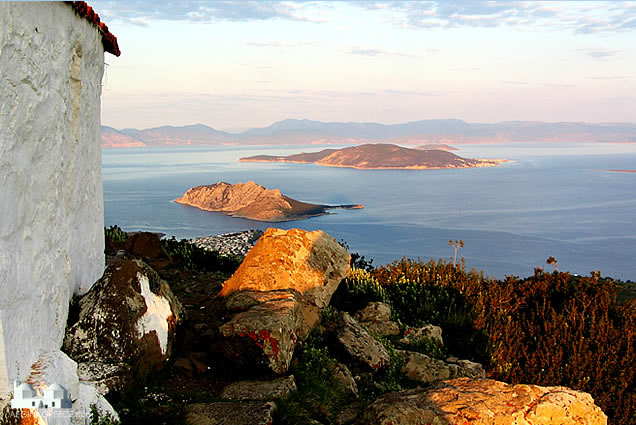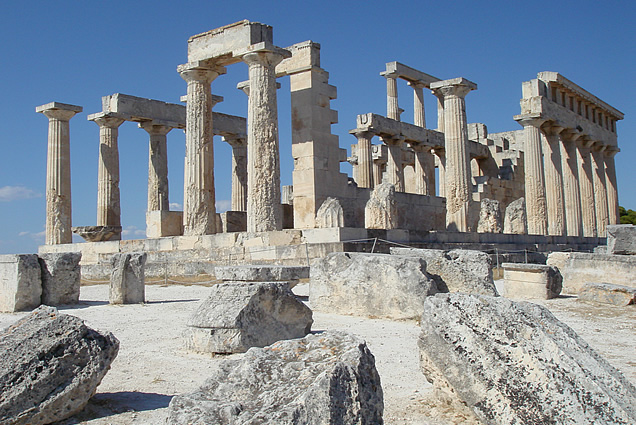
A perfect holiday destination

So, what is it about Aegina which attracts so many people to use their precious holiday to return here year after year? Why do others dream about living on Aegina all year long and some actually take the plunge and do it by relocating here permanently? Curious? Once you experience it for yourself you will understand. In the meantime, let us paint a picture of this magical island.
Location
Our location in the Argo-Saronic gulf is an immediate attraction. Aegina is close to the port of Pireaus on the mainland. Visitors must arrive by boat but the journey is short (between 40 and 80 minutes depending on which boat) and an enjoyable part of your holiday experience. Enter into the bustling port of Aegina town and drink in the view: a moon crescent harbour with fishing boats, fruit filled caiques, and glamorous yachts jostling for position. Once on Aegina you can enjoy island life but easily leave for day trips to Athens, the Saronic islands - Agistri, Poros & Hydra - and the Peloponnese.
History
Those visitors who are excited by learning about history will not be disappointed by what Aegina has to offer. Indeed there are many excellent books available and a separate section on this website. The island has a special place in Greek mythology and history. The myth has it that the island tookits name from the most beautiful of the twenty daughters of Asopos, the river god, who eloped with Zeus to the then deserted island. In historical terms, there is evidence that the island was inhabited from as early as 3500 B.C. The island enjoyed strong economic and social growth between around 900 B.C. and 480 B.C., including minting the first coins anywhere in Greece during the 7th. Century B.C. In more modern times, Aegina was briefly the first "capital" of modern Greece from 1827 – 1829.
Aegina has a long history, dating from the Neolithic (4th millennium BC) to the later years. The high points in its history were the period if its great prosperity (657-459 BC) and the short period when it was proclaimed first capital and home of governor Ioannis Kapodistrias.
Witnesses to this historical path are the hill of Kolona with its characteristic column and the findings of ancient settlements, Paleachora with its post-byzantine churches, the Temple of Afea, the public buildings of the Kapodistrian period, Mount Hellanion/ Oros and the monastery of Chrysoleontissa.


The island's name
Orginally the island was called Inoni (or Inona or Inopia). Its name comes from Aegina, one of the 50 daughters of the river god Asopus, who was loved by Zeus.
The king of Olympus, in order to avoid, Hera, tranformed himself into an eagle and carried Aegina to the so far uninhabited Inoni. The fruit of Aegina's and Zeus' passion was Aeakos the first king of the island.
Aeakos asked Zeus to give him subjects and so he transformed the ants of the island into humans for his skae. The first inhabitant of the island were called Myrmidones, from the Greek word "myrmigi" which means ant.
Ideal for the independent traveller
Arguably one of the main attractions of Aegina is that it is a real living and working island. Thankfully not a victim of mass tourism, Aegina is the perfect destination for the independent traveller who yearns to experience some reality of the country she is visiting. Those who are well travelled in Greece will note that Aegina is not as "manicured" as some islands popular with foreign tourists. It hosts mainly Greek weekend visitors. This simply adds to the charm. Populair sites to visit are: the temple of Aphaia and the church of Agios Nektarios. Learn more about the traditions and culture of Aegina on this website.
Food and drinks
One of the joys of travel is to experience local food and drink. If you are looking for one of the last remaining places on earth without a MacDonald’s restaurant then come to Aegina! Unlike many other Greek holiday destinations you will be glad to note the absence of bill-boards advertising "full English breakfast" or "chicken schnitzel". At breakfast, do as the Greeks do and simply enjoy a slow coffee at one of the sea-front cafes. Snack on fresh cheese and spinach pastries from the bakery and fruit from the caiques. A true delight is ouzo with mezedes or a cold beer in the sunny afternoon. Finally, finish your day as you started by doing as the Greeks do and enjoy a late dinner in one of the fantastic tavernas. Salad, fresh fish, grilled meat….
Beaches
Of course, many people choose to come to Greece for summer holidays to experience the beach and swimming in the sea. Again, Aegina will not disappoint. There are several good sandy beaches on the island from which you can delight in the clean and crystal clear waters. Beach life can be simply enjoyed by finding a quiet spot for you, your towel and book. Otherwise, grab a bed with umbrella somewhere more organised where drinks and snacks can be delivered to you whilst you recline.
When to visit
We recommend Aegina to you out of the high holiday season also. Spring and autumn are excellent times of the year to visit. The weather is sunny, warm and energising. Indeed, Aegina is reputed to have the mildest climate in Greece. Pull on your comfy shoes and explore our natural landscapes. There is some excellent walking to be had on Aegina; ancient abandoned villages on hillsides; awe inspiring olive tree groves; clamber to the top of Mount Oros with its fantastic sea views & pistachio tree orchards (Aegina’s most famous export).

Δεν υπάρχουν σχόλια:
Δημοσίευση σχολίου